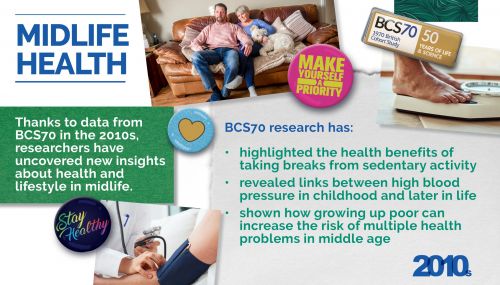Important discoveries from the 1970 British Cohort Study – Midlife health
50 stories
25 February 2021

The first BCS70 Biomedical Sweep since childhood took place when study participants were aged 46-48.
A variety of objective health measurements were collected, including blood pressure, grip strength and balance. Participants also provided blood samples so that these could be analysed for cholesterol among other things. The information cohort members provided has been used in a range of important research exploring the factors associated with good and poor health in midlife.
In a BCS70 first, for the age 46-48 Sweep, participants were asked to wear an activity monitor on their thigh for a week so accurate data could be gathered about time spent sitting, standing, moving and sleeping. Almost 6,500 cohort members agreed to the thigh-worn activity monitor, with more than 83% (5,300) returning their monitors with useable data for at least one day of wear. The data collected, analysed in conjunction with other rich survey information, has enabled researchers to examine how physical and sedentary activity impacts people’s health.
In one study, researchers found that those who spent the most time sitting – more than 10 hours a day – were more likely to be obese, to smoke and to report higher rates of poor health and disability.
In another study, researchers used the activity monitor data alongside other information collected to investigate physical inactivity as a risk factor for diabetes.
Cohort members were asked if they had been diagnosed as diabetic and if they were taking medication for diabetes. In addition, the blood samples they provided were analysed for levels of HbA1c – glycated haemoglobin. A high level of HbA1c means there is too much sugar in the blood.
The researchers found that taking breaks from sitting down was important for reducing people’s risk of diabetes. Each set of additional 10 sedentary breaks (the transition from sitting to standing) per day was associated with 20% lower odds of developing diabetes. In addition, independent of total sedentary time, each extra hour of moderate to vigorous activity was associated with 58% lower odds of diabetes.
Health measures captured when cohort members were children were repeated in the 46-48 Sweep, including for blood pressure.
Study participants had their blood pressure measured when they were aged 10 and 16. Researchers have analysed these readings with those collected when cohort members were in their 40s to see how blood pressure tracks from childhood to midlife.
In one study, researchers found that children who recorded higher levels of blood pressure at age 10 were at around twice the risk of developing hypertension (clinically elevated blood pressure) by their mid-40s. The odds of hypertension in midlife were even greater for those who had elevated blood pressure at age 10 that had continued to rise above average levels through to age 16.
In a separate study, researchers used a range of objective and self-reported data collected in the Age 46-48 Sweep to analyse the factors associated with having multiple health problems in midlife (such as hypertension, diabetes, heart problems and mental health problems).
The researchers found that the prevalence of multimorbidity (having two or more long term health conditions) in BCS70 at age 46-48 was 33.8%.
The most common individual health outcomes were high-risk drinking (26.3%), recurrent back problems (20.9%), and mental health problems (19.1%). Among the most prevalent chronic physical health conditions were asthma/bronchitis (11.7%) and arthritis (7.7%).
The researchers found that those who grew up in the poorest families were at increased risk of having multiple health conditions in middle age. Other risk factors included lower birth weight, lower cognitive ability (at age 10), higher BMI (at age 10) and more emotional and behavioural problems at age 16.
Read more:
Cross?sectional associations of device?measured sedentary behaviour and physical activity with cardio?metabolic health in the 1970 British Cohort Study
Feasibility of Measuring Sedentary Time Using Data From a Thigh-Worn Accelerometer: The 1970 British Cohort Study
Blood pressure trajectories in youth and hypertension risk in adulthood: the 1970 British Cohort Study
Prevalence and early-life determinants of mid-life multimorbidity: evidence from the 1970 British birth cohort
Back to news listing





